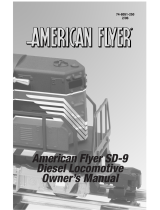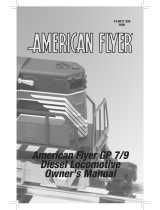
5
Model railroading with the LionChief system
Y
our ready-to-run LionChief train set comes with a DC wall-pack power supply, a LionChief
remote control, a LionChief-equipped locomotive, rolling stock, and a FasTrack oval, complete
with a wall-pack terminal section for “plug-and-play” set up.
Your locomotive runs on fixed voltage, which is optimal for the sound system, smoke system,
and lamps. The locomotive listens to commands from its LionChief remote at a specific frequency
to increase or decrease speed, change directions, or trigger sounds. That’s why the locomotive and
remote must be operated as a matched pair.
The DC wall-pack power supply is capable of running the locomotive and cars that come with
this set, plus a few add-on cars and accessories, depending on the power they require. Keep in mind
that your locomotive can run on AC power, too, so you may choose to upgrade to most Lionel or
Lionel-compatible AC transformers (available separately at your authorized Lionel retailer) when you
expand your layout.
Important! Run only your layout with only the DC wall-pack power supply OR an AC transformer.
Do not run both! Also, keep in mind that most other Lionel locomotives require AC power specifically;
check the instructions included with the other locomotives.
If you do choose to run your LionChief locomotive with a transformer, set the train voltage to full
(18 volts) and use the remote to run the train and trigger the sounds. The locomotive is not designed
to respond to the transformer’s throttle, direction button, horn button, or bell button; the locomotive
only responds to commands from its LionChief remote.
Keep in mind that the remote that comes with the train set is paired with the locomotive. This
locomotive and remote share a frequency, and your LionChief remote will not communicate with
other locomotives. However, locomotives of the same type, for example a 2-8-4 berkshire, may share a
frequency. Where the frequency is shared, any locomotive of the same type on the track would respond
together, at the same time, to commands from a remote. To avoid this scenario, you may choose not
to run multiples of the same locomotive type at the same time.
Otherwise, you may run more than one LionChief-equipped locomotive on the track at the same
time. You may also choose to run your LionChief locomotive on a LEGACY Control System-equipped
layout; however, you must use your LionChief remote control to control the LionChief locomotive
(LionChief locomotives do not receive commands from the LEGACY remote).
LionChief system basics





















